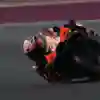
MotoGP
MotoGP was launched in 2002 and its regulations have been evolving ever since. The result? An absolute formula for success that has become a great model in the world of motorsport.
When a motorbike world championship was held for the first time in 1949, the 500cc class was soon considered the premier class. It was the fastest motorbikes in the hands of the most renowned pilots in the world. With the emergence of the Japanese manufacturers in the late 1960s, two-stroke engines became widespread.
Since they offered more power than four-stroke engines with the same displacement, they dominated the championship until the governing bodies decided to ban the two-stroke engine in the early 2000s because it was considered obsolete. The two-stroke engine had all but disappeared from series production and became increasingly rare. From then on, a new premier class developed and MotoGP was born.
01
A new horizon

From 2002, the Grand Prix motorbikes were equipped with four-stroke engines and a displacement of 990 cc. However, in that first season, 500cc two-strokes were still allowed for private teams to make the transition as smooth as possible.
These new racing machines changed the world of Grand Prix racing forever. Honda, Yamaha and Suzuki immediately jumped into the new adventure. Aprilia teamed up with Cosworth to develop a three-cylinder engine with technology derived from Formula 1. In Japan, Kawasaki was also preparing to join the constructors' party. Ducati, who dominated the World Superbike Championship at the time, announced their entry into MotoGP. Kenny Roberts started his project with Proton at the same time and developed a 5-cylinder engine. An engine that was also chosen by Honda for the RC211V. Honda was to win the first two world championships with it.
02
Limited cubic capacity
Shortly afterwards, a rule change in MotoGP followed, limiting the engine capacity to 800 cc. The decision was aimed at limiting the power and speed of the bikes. Honda then removed one cylinder from their engine, Yamaha and Kawasaki remained faithful to their four-cylinder engines, while Suzuki and Ducati adapted their V4 to the new regulations.
The Italians coped best with this new situation. In 2007, Casey Stoner won 10 of the 18 races on the MotoGP calendar. The Australian, who had only joined the Ducati team at the beginning of the year, won his first world title with a 125-point lead over Dani Pedrosa and his Honda.
At the end of 2008, Kawasaki decided to withdraw from MotoGP. At that point, all teams were tyred by Bridgestone. Since 2005, riders were allowed to change tyres, and thus the bike, if it suddenly started to rain in a previously dry race. In technical jargon, this is called a "flag-to-flag" race.
03
The show must go on
After the premier class, it was the 250cc class that underwent a major technical change in the past. The 250cc two-stroke two-cylinder gave way to a new generation of machines with a proto-type chassis powered by a 600cc serial four-cylinder and manufactured by Honda.
The top dog in the international constructors' race thus became the official engine manufacturer of the new Moto2 class, just as Dunlop became the sole tyre supplier. Two years later, it was the turn of the 125cc class to make way for a new racing category called Moto3. The single-cylinder two-strokes were replaced by 250cc four-strokes. Unlike Moto2, the engines in the newer entry-level class are not limited.
In 2012, the engine capacity in MotoGP was increased to 1000 cc. The dominance of Spanish riders began: between 2012 and 2020, the title of riders' world champion went to Spain, led by MotoGP legend Marc Marquez.
Two years later, the federation decided to allow, on the one hand, the six factory bikes from Honda, Yamaha and Ducati with 20 litres, five engines and their own software and, on the other hand, to introduce an Open class in which everyone was allowed to compete with the new standardised ECU from Magneti Marelli, 24 litres of fuel and twelve engines.
This open class was abolished in 2016 with the introduction of unified electronics and the switch to a maximum fuel capacity of 22 litres for all motorbikes. In the same year (2016), Michelin took over tyre supply, replacing Bridgestone.
This ensured that the forces in MotoGP were balanced. With the 2017 MotoGP season came one of the most exciting championships in the history of the sport.
Our film 'Unseen' focuses on this legendary season, in which things were hot on and off the slopes right up to the last minute:

04
MotoGP rules: E-fuels decided from 2024
While the current MotoGP rules have now been in place since the 2022 season, a rule change for 2024 has already been decided.
From the 2024 MotoGP season, manufacturers will have to use fuel that is at least 40 per cent of non-fossil origin - so-called "e-fuels". From 2027, the fuel must then be completely sustainable.
Whether the MotoGP bikes will move into a hybrid era in the future or stick to the combustion engine is still unclear.
What is clear, however, is that the premier class of motorbike sport is not ignoring the issue of sustainability. The bike from KTM, runner-up in the 2022 MotoGP season, for example, can be more than 90 percent recycled.













